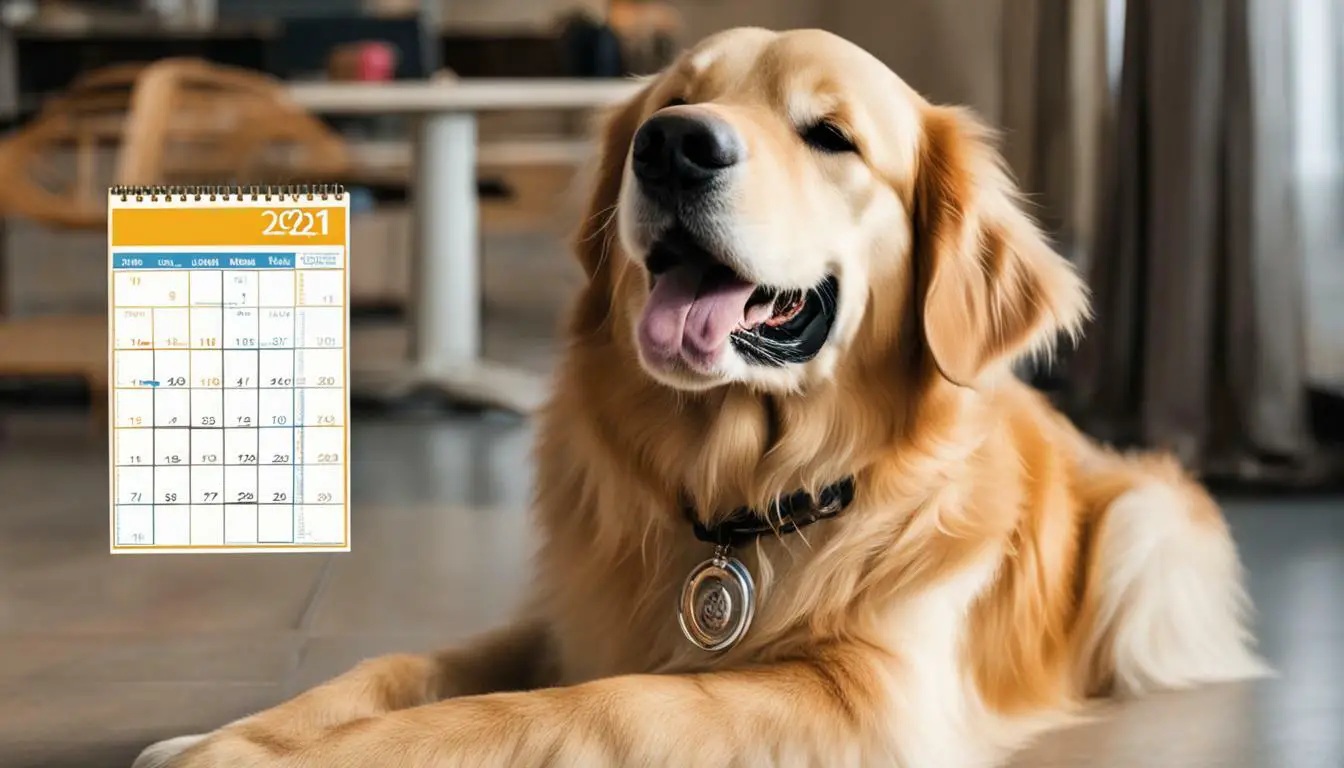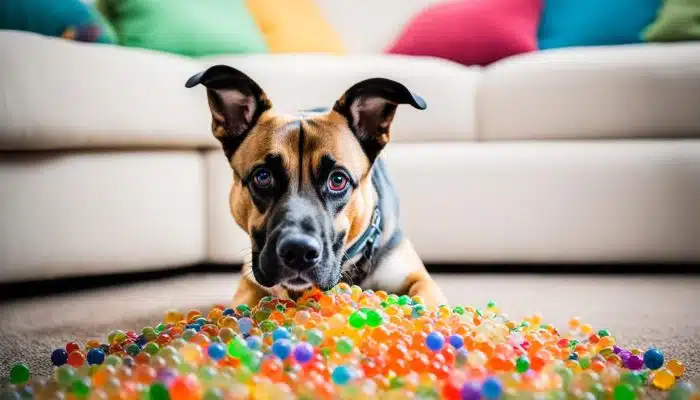As a professional copywriting journalist, I understand the importance of knowing your golden retriever’s heat cycle frequency and breeding patterns. If you’re a golden retriever owner or breeder, this information is crucial for maintaining the reproductive health and fertility of your dogs.
The golden retriever heat cycle, also known as the estrous cycle, is a reproductive cycle that female golden retrievers go through. In this article, we will delve into the different stages of this cycle and discuss how often female golden retrievers typically go into heat. We’ll also explore the various factors that can affect their heat cycle frequency and provide tips on caring for your golden retriever during their heat cycles.
Key Takeaways
- Understanding your golden retriever’s heat cycle is essential for maintaining their reproductive health and fertility.
- The golden retriever heat cycle, or estrous cycle, is a reproductive cycle that female golden retrievers go through.
- Female golden retrievers typically go into heat every 6-8 months.
- Several factors can influence their heat cycle frequency, including age, health conditions, and external environmental factors.
- Proper care during your golden retriever’s heat cycles is crucial for maintaining their reproductive health.
The Golden Retriever Heat Cycle
As a proud owner of a female golden retriever, it is important to understand the estrous cycle, also known as the heat cycle, that she goes through. This cycle is a recurring process in which her body prepares for potential pregnancy.
On average, the heat cycle for golden retrievers lasts between 2 to 4 weeks. It is divided into four stages: proestrus, estrus, diestrus, and anestrus.
Proestrus stage – This is the first stage of the heat cycle and can last anywhere from 3 to 17 days. During this stage, you may notice that your golden retriever’s vulva is swollen, and she may experience a bloody discharge. This is the stage where she is not yet ready to breed.
Estrus stage – This is the second stage, also known as the “standing heat,” and typically lasts around 3 to 11 days. During this stage, your golden retriever’s discharge may become lighter in color, and she may show interest in male dogs. This is the optimal breeding period.
Diestrus stage – This stage follows the estrus stage and lasts around 60 to 90 days. If your golden retriever is not pregnant, her body will begin to return to its normal state. During this stage, you may notice that her behavior returns to normal.
Anestrus stage – This is the final stage of the heat cycle and can last around 4 to 5 months. During this stage, your golden retriever’s reproductive system is at rest, and she will not go back into heat.
It is important to keep track of your golden retriever’s heat cycle to ensure her reproductive health. If you notice any abnormalities, such as prolonged bleeding, consult your veterinarian immediately.
Remember, understanding your golden retriever’s reproductive health is crucial for her overall well-being, and it starts with comprehending the estrous cycle.
Frequency of Heat Cycles in Female Golden Retrievers
As a golden retriever owner or breeder, it is important to understand how often female golden retrievers typically go into heat. The breeding season for golden retrievers usually occurs twice a year, and each cycle lasts for approximately 21 days.
However, it is essential to note that this timeline can vary depending on various factors, including the age of the golden retriever, their overall health condition, and external environmental factors such as climate and daylight hours.
Younger female golden retrievers may experience heat cycles more frequently, with some puppies starting as early as six months of age. However, it is generally recommended to wait until the female has had at least two heat cycles before considering them for breeding purposes.
Conversely, older female golden retrievers may experience longer intervals between heat cycles and may even skip cycles entirely. In this instance, it is best to consult with a veterinarian to ensure your golden retriever’s reproductive health.
Understanding the frequency of heat cycles in female golden retrievers is crucial for planning breeding schedules and effective management of their reproductive health. By being aware of their breeding season and heat cycle patterns, you can ensure the optimal health and well-being of your beloved golden retriever.
Factors Affecting Heat Cycle Frequency
As a responsible golden retriever owner or breeder, it’s important to understand the factors that can affect the frequency of your dog’s heat cycles. These factors can impact their reproductive health and fertility and should be taken into consideration when planning breeding schedules and managing their overall well-being.
Age: Age is a crucial factor that can affect the frequency of heat cycles in female golden retrievers. Typically, they start going into heat when they are around six months old. However, the frequency and regularity of their cycles can change as they age. For instance, older females may have fewer and less predictable heat cycles, while younger females may have more frequent cycles.
Health conditions: Health issues can significantly impact a golden retriever’s reproductive health and fertility. Certain conditions like hypothyroidism, ovarian cysts, and uterine infections can affect the frequency and regularity of heat cycles. It’s important to consult with your veterinarian if you notice any changes in your dog’s reproductive health, including irregular heat cycles.
External environmental factors: External environmental factors, such as changes in daylight hours, can also impact the frequency of heat cycles in golden retrievers. Some studies suggest that female dogs may go into heat more often during the winter months, while others have found that daylight hours can affect their reproductive cycle.
Overall fertility: A golden retriever’s fertility can also impact their heat cycle frequency. For instance, females that have difficulty conceiving may experience more frequent heat cycles in an attempt to increase their chances of breeding.
In conclusion,
Several factors can impact the frequency of heat cycles in female golden retrievers. As an owner or breeder, it’s essential to understand these factors and take appropriate measures to manage their reproductive health and fertility. Regular visits to the veterinarian, proper care and nutrition, and allowing sufficient recovery time between breeding cycles can all help ensure the well-being of your golden retriever.
Breeding Considerations for Golden Retrievers
As a breeder, it’s important to consider the optimal breeding frequency for your female golden retriever. Breeding too frequently can put a strain on their reproductive system and may lead to health issues.
Most experts recommend waiting until the female golden retriever is at least two years old before breeding. This allows for proper physical and emotional development. Additionally, it’s best to wait at least six months between heat cycles before breeding again. This allows the dog’s reproductive system to recover and reduces the risk of health complications.
Breeding your female golden retriever too often can also decrease their fertility. It’s important to give them enough time to fully recover between litters, and to monitor their reproductive health regularly.
It’s also important to carefully consider the male golden retriever used for breeding. The male should be healthy and free of any genetic health issues that could be passed on to the puppies.
Overall, taking a responsible and careful approach to breeding can help ensure the health and well-being of your golden retrievers and their offspring.
Reproductive Health and Care
As a golden retriever owner, it is crucial to prioritize your dog’s reproductive health during their heat cycles. Proactively caring for your dog’s reproductive system can help maintain their overall well-being and fertility.
One important aspect of reproductive care is monitoring your dog’s behavior and physical symptoms during their estrous cycle. Pay attention to changes in their appetite, energy level, and mood. You may also notice vaginal discharge or swelling of their vulva, which are typical signs of being in heat. Keeping track of their cycle can be helpful in identifying any changes or abnormalities in their regular patterns.
Another essential part of reproductive health care is providing your dog with proper nutrition. Be sure to feed them a well-balanced diet that includes essential vitamins and minerals to support their reproductive system. You may also consider incorporating supplements such as omega-3 fatty acids and antioxidants into their diet to promote reproductive health.
Regular exercise and physical activity are also vital components of reproductive care. Exercise helps maintain your dog’s overall well-being and can improve their reproductive health by promoting blood flow to their reproductive organs. However, avoid over-exercising your dog during their heat cycle, as it may cause stress and physical strain on their body.
If you plan on breeding your golden retriever, it is essential to consult with a veterinarian to ensure their reproductive health is optimal. A vet can provide guidance on breeding schedules and recommend genetic testing to avoid passing on any inherited disorders to their offspring.
In conclusion, taking care of your golden retriever’s reproductive health is an essential part of being a responsible dog owner. By monitoring their heat cycle, providing proper nutrition, exercise, and consulting with a vet, you can help ensure their reproductive system remains healthy and fertile.
Conclusion
As a golden retriever owner or breeder, understanding the heat cycle and fertility of your dog is crucial for their reproductive health and overall well-being. By being aware of the frequency at which golden retrievers go into heat and the factors that can affect their cycles, you can take the necessary steps to ensure proper care and management.
It is important to keep an eye on your golden retriever’s health and behavior during their heat cycle, as well as provide them with appropriate care and attention. As a responsible breeder, you should also consider the optimal breeding frequency for your female golden retriever and allow for sufficient recovery time between cycles.
Overall, by taking the necessary measures to maintain the reproductive health of your golden retriever, you can enjoy a strong and healthy bond with your beloved pet. Remember to always seek professional veterinary advice if you have any concerns or questions about your golden retriever’s reproductive health.
FAQ
How often do golden retrievers go into heat?
Golden retrievers typically go into heat every 6 to 8 months. However, this can vary between individual dogs.
What are the signs that my golden retriever is in heat?
Signs that your golden retriever is in heat include swelling of the vulva, increased urination, changes in behavior, and attracting male dogs.
How long does the heat cycle last in golden retrievers?
The heat cycle in golden retrievers usually lasts around 2 to 3 weeks. However, this can vary between dogs.
Can I breed my golden retriever during her heat cycle?
Yes, you can breed your golden retriever during her heat cycle. However, it is important to consult with a veterinarian and ensure proper planning and care during the breeding process.
How many times can I breed my golden retriever in a year?
It is generally recommended to breed a golden retriever no more than 2 to 3 times in a year. This allows for proper recovery and overall reproductive health.
What factors can affect the frequency of heat cycles in golden retrievers?
Factors that can affect the frequency of heat cycles in golden retrievers include age, health conditions, and external environmental factors.
How can I take care of my golden retriever during her heat cycle?
During your golden retriever’s heat cycle, provide a calm and comfortable environment, keep her on a leash when outside, and consider using doggie diapers or pads to manage any discharge.
Are there any health concerns during a golden retriever’s heat cycle?
It is important to monitor your golden retriever for any abnormal signs or symptoms during her heat cycle. If you notice anything concerning, consult with a veterinarian for proper guidance and care.





